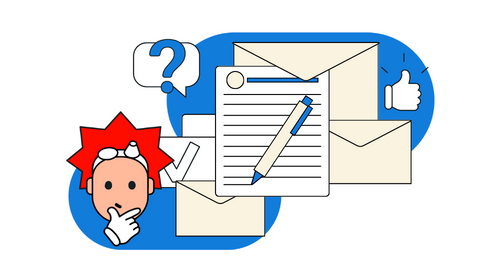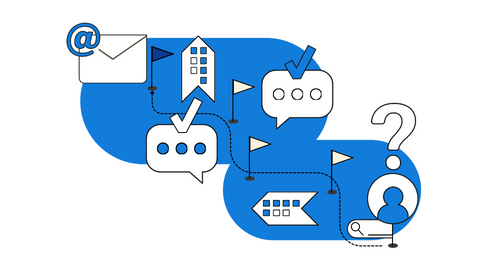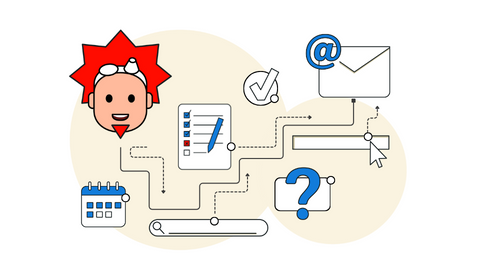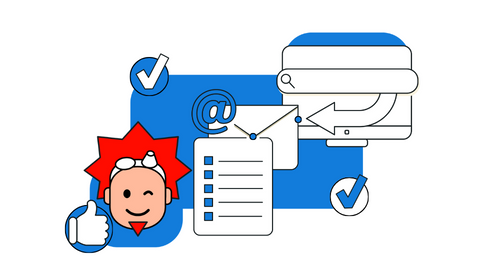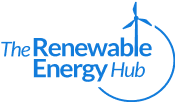Let me read your mind about the last outreach email you wrote and sent.
You found some template in Google, made a few quick edits, sent your pitch to many recipients, and ended up with results as if you did no outreach at all. If you’re not your own boss, you must have felt ashamed to report such a “progress” to your manager.
How do I know?
Mind-reading is not my thing. It’s just what happens to many outreachers, basically for two reasons:
- their content sucks;
- their outreach email sucks.
If your content takes you down, check out this guide.
If the problem is your message, read on.
For years, I’ve received tons of email pitches made wrong and, truth be told, sent no better pitches myself. No friendly tone, no decent personalization, no emphasis on the value for recipients…
I bet that’s exactly what you’re missing too.
Let me guide you on how to write an outreach email pitch with all the key points in mind. At the end of the day, you should get closer to your prospects and further away from their spam folders.
But before I start talking about how to write an email outreach pitch, I want you to promise one thing – you will not send spam emails to anyone no matter how tempting it might be.
Yeah, you probably nod your head and say you’re not sending spam emails, but in practice, you still do so. Remember when you last opened a spammy email? What did it feel like? What did you do right after?
Don’t make others feel the same way!
OK, now let’s get back to the guide on how to write a great outreach email.
How to write email subject lines that get opened
The first roadblock on your way to a successful email marketing campaign is your subject line.
Day by day, bloggers get their inboxes filled with outreach emails of any kind – newsletters, guest post offers, interview requests, and a lot of spam that doesn’t always make its way to the corresponding folder. No one physically can read them all. To streamline the email sorting process and prioritize genuine outreach, bloggers can benefit from using an SPF checker, ensuring that authentic messages from trusted sources stand out in their inboxes.
If your subject line gets lost among others, your pitch will remain unopened.
Check out the best practices for email subject lines. I included those that helped me increase the open rates of my letters.
Cut your email subject line length
Problem. Long email subject lines get truncated in inboxes, especially when people check them on smartphones. And we’re all on the go today, aren’t we?

Solution. Minimize your email subject length so that it could fit on the screen of any size. It’ll improve your open rates on mobile devices.
Being a foreword, your subject shouldn’t reveal everything you have to say. Just drop a hint of what your message is about or how it’s related to your outreach prospects.

Note. Don’t take my words too literally. Yes, your subject line should be short, but not so short that it doesn’t convey the main idea of your email pitch.

Let’s take the “about SEO” subject, for example. Are they going to hire me as an SEO for their project? Do they want to discuss some SEO news like the latest Google algorithm update? Have they noticed any SEO issues on my blog?
Forcing people to make such guesses is nothing but bad manners. It can also give them a feeling that your pitch is one of many other spam emails landing in their inboxes day in, day out.
Avoid capitalization in email subject lines
Problem. A lot of personal outreach emails remain unnoticed because they look like automated newsletters.
We all know the rule to use capital letters in post titles. By analogy, email subject lines are titles of our emails, but this rule doesn’t work here.
Email subject capitalization only gives a licked-clean, promo look to a message.
Your goal is to send a pitch reminding of a friend’s message. Do you ever capitalize words when chatting with your buddies? I don’t.
Solution. Use lowercase letters only in your subject lines.
Here’s how an all-lowercase subject stands out among newsletters in the inbox.

Note. It’s justified to capitalize email subject words like acronyms or, say, personal names.

Make your email subject lines sound relevant
Problem. When people read your subject line, it should ring a bell for them. If it doesn’t, they will just scroll it by, thinking your outreach email has nothing to do with them.
Solution. The most opened subject lines are those that sound relevant to recipients. To achieve such an effect, use their post titles.
That way, you won’t need to specify which post you’re referring to in the email body. Such a subject makes it obvious and helps you reduce your email length (more on this in the next section).

Note. Don’t copy and paste the entire post title. It’ll only make your subject longer and give it a hint of automation.
If you copied and pasted the title, the odds are your entire message is a matter of copy and paste too. Such a thought will push recipients away if they notice your email at all.
Due to copypasted titles, personal outreach emails don’t stand out among newsletters visually. Guess which of the three emails below is personal 🙂

Shorten post titles to keywords only. That’d be enough to let your prospects know which post is on your mind.
Arouse some curiosity with your email subject line
Problem. To read boring emails at the end of the day or close the mailbox and go home, that is the question…
The answer is often not in your favor, I’m afraid.
Without engaging email subject lines, people will be reluctant to read your entire message. That’s something I can say with confidence, from personal experience.
Solution. Arouse your outreach prospects’ curiosity with a question about their content.
Logically, everyone who’s interested to write about some topic should also be interested to discuss their write-up consequently. Many recipients will be curious to check what kind of question you have.

Note. Don’t ask your question directly in the subject line. People can say no in their minds and move on to other email pitches, leaving yours unopened.

Also, your question will make more sense in the context of your arguments rather than on its own.
Accentuate the value for your outreach prospects
Problem. People skip many outreach emails because they don’t see any value there. Just another hard sell or stuff like that.
Can you blame them?
Many outreachers are focused on their own benefits only. Asking for links and shares, they aren’t ready to give anything in return.,/p>
That’s why folks have been quite skeptical about unsolicited email pitches lately.
Solution. The best subject lines to get emails opened are those that accentuate the value for recipients.
Tell your outreach prospects that you have an idea or tip for their content.
No one’s canceled a writer’s block after all. Many bloggers face it at one time or another but few admit though 🙂
Your content idea offer should motivate them to open your email and check if it’s worthwhile.

If you’ve done a case study, offer bloggers to embed your graphs in their articles. That way, they’ll back up their ideas with stats instead of sounding proofless.
Note. Don’t use any clickbait tricks to increase your email open rates. As the end goal of your outreach is to ask for a backlink, such exaggerations look ridiculous.

First, you’re not the one who’ll provide “big help” in the end. It is your outreach prospect who will help you with a backlink.
Second, you’ll look like a boaster calling your ideas “awesome,” “exclusive,” “great,” etc. Self-praise is not the quality people normally respect.
The same goes for fake flattery like “your amazing blog.”

I want to assure you that everyone knows you’re insincere. When they see your link request at the end of your message, you’ll prove that one more time.
Don’t let such dirty tricks alienate your prospects from you.
Another way to increase email deliveribility rate and boost the email credibility is by securing your email domain. You can check your email security compliances with an email header analyzer.
Get straight to the point in your email subject line
Problem. When people have to deal with lots of emails, the last thing they want is empty talk.
Talkers and other time wasters are out of favor. So are their pitches with vague subject lines.
Solution. To save your outreach prospects’ time, get straight to the point.
Especially if it can trigger some sort of emotion like wonder or excitement. To come up with such a subject, answer these two questions:
- How is your post better than the one your prospects link to?
- What have you found out no one knows about?
Contradiction to common knowledge can give you an easy win here.
Let’s say your prospects link to a compilation of keyword tools. You can surprise them that not all of those tools turned out efficient for their industries, according to your tests.
Such a spoiler will strike the eye for sure, adding some intrigue to your email’s look and feel.
Here are examples of attention-grabbing email subject lines.

Note. Saying that you have a study related to their topic won’t work. It sounds too general.
Every content guru out there suggests doing research. As a result, so many people are doing case studies these days, but how is yours different?

To write a catchy email subject, you need to reveal the data that will surprise your recipients.
If you still want to prove that your findings aren’t taken out of nowhere, mention your content type in brackets at the end. It can be an interview of a niche influencer, a survey of many product users, or your test results.

It was the last of my email subject line tips for you. For more inspiration, check out this cool post with currently 164 ideas on the list.
What is the correct email format in outreach
Once your subject line passes face control, your outreach prospects will open your email where things usually go wrong.
Before even reading the first line, they’ll evaluate your message by eye. Make sure it doesn’t look overwhelming and has nothing that could turn them off.
Learn how to format an email pitch in a way to retain your prospects at this to-read-or-not-to-read stage.
Stick to a non-promotional email design
Problem. Any outreach email enframed in a professionally designed template feels like a promo in one way or another.
And any hint of promotion makes your pitch closer to the spam folder, no matter how beautiful that template is.
I apologize to designers of email templates but I have to state the obvious. You don’t use a $20 template to message your friend, do you?

Solution. The best email design practice in blogger outreach is to avoid any visual enhancements.
Being plain and simple, your email will look natural. This is exactly the effect you need.
Note. Before template designers curse me for pushing their customers away, let me stress one thing.
Pre-designed email templates are OK for newsletters. If you send them, feel free to use such templates without worries.
Limit your email length to a few short paragraphs
Problem. When you open an outreach email and see a wall of text as below, do you want to read it?
Maybe… But what if you have 30 more pitches like this to read? I doubt it.

Liz from AWeber has posted current email marketing stats, one of which says the average email takes 3.3 minutes to read.
Who wants to spend so much time on email correspondence, especially if it’s not their direct work duty? Unlike communications managers, writers don’t get paid for replying to each letter they get. And they are your major outreach prospects after all.
Don’t increase your email bounce rates with such walls of text.
Solution. As is the case with subject lines, “less is more” should be your email length rule to follow.
Short, easy-to-scan pitches are your tickets to success in modern-day outreach.
Break down your message into a few short paragraphs to make the info easy to digest. If you have more than one talking point, arrange them in a bulleted list.
Look at the email formatting example below. It’s just an online newsletter that was automatically sent to multiple subscribers. But its brevity makes it a good read, which took me like half a minute only. Thanks!.

Note. If you keep your subject line concise (and I hope you do), there’ll be a short preview of your email pitch right in the inbox.
Make sure it doesn’t include anything meaningless. I’m referring to questions about people’s well-being, weather, and anything else that we say out of politeness.

Don’t let this blah-blah-blah disrupt your optimal email length and show yourself as talkative.
Use a friendly email tone
Problem. Trying to sound intelligent, outreachers often cross the line.
They use formal, complicated language that’s hard to read – long sentences, complex grammatical constructions, and fancy words that you can find mainly in classic works of literature.
The way you talk has a direct impact on how eager your outreach prospects will be to read your email.

Solution. Unless you reach out to university professors, stick to an informal email tone.
Ideally, your language should sound as if you’re talking to a friend. The friendlier, the better.
Here’s how to rephrase the overcomplicated message above in plain language.

Note. Speaking about email tone etiquette, there’s a fine line between being friendly and trying to butter someone up.
Many outreachers tell their prospects how much they love their blogs, particularly articles they want backlinks from. But such fake love confessions don’t work, sorry.

So, Anthony, you’ve been reading my blog for years.
Hmm, where are your likes, shares, and comments? Why can’t I find you in my subscriber base? Why have you linked to none of my articles over these years if you like them so much?
Come on, no one will buy it unless you can prove your words.
Btw, if you think about retweeting your prospects’ posts a few days before emailing them, don’t bother 🙂 This manipulation would be too obvious.
Spell check email pitches before sending
Problem. Outreachers are usually quick to write an email pitch and hit the send button. It takes them only a few seconds to notice spelling mistakes afterward.
Oops…

If you don’t spell check email pitches, people will either put your IQ score in question or think you don’t respect them enough to approach with due diligence.
Yeah, I know that in the previous section I suggested writing a message as if it’s addressed to a friend.
While it’s no big deal to make a few typos when messaging pals, outreach emails require more attention to detail. There should be nothing that your prospects could find fault with.
Solution. Install a free email grammar checker like Grammarly to proofread your message before sending it. Quite handy!

Note. It’s OK to use colloquial speech (“ya” – “you,” “doin’” – “doing,” etc), even if your email spell checker highlights them as misspellings.
How to structure an email pitch
As mentioned in the previous section, your outreach email should be short, basically around ten sentences.
There’s no place for any digressions from the main point of your campaign. But I’m amazed how much info that’s beside the point outreachers sometimes shove into their pitches.
Just like every article consists of a few major parts (an opening, main part, conclusion), there’s a predefined structure of an email too.
Here are the main email parts you should include in your pitch.
Email greetings
Problem. When you don’t address your outreach prospects by name, it’s a red flag that your message ended up in hundreds of other mailboxes.
Unfortunately, bulk email senders don’t get bulk replies.
The worst part is that people will figure things out without even opening your email. The snippet with its first line is visible right in the inbox.
Imagine how the lack of a personal email greeting will affect your open rates.
Solution. If you wonder how to address people in email pitches, the answer is obvious – by name!
In such a simple way, you’ll show that you actually know who you contact. It’s in our DNA to want to check out stuff addressed to us personally, at least out of curiosity.

Note. Don’t use anything like “Dear Editor,” “Dear Sir,” “Dear Madam,” etc.
No, such a formal address won’t show your utmost respect for recipients. What it’ll show is that you’re so lazy that you didn’t even bother to check out their names.
A proper email greeting is the easiest way of personalization but many outreachers still fail here.

Email opening lines
Problem. Email opening lines are notorious for being the most irrelevant part that recipients usually skip over.
When thinking about the ways to start an email, many outreachers tell a backstory about themselves, their interests, companies, products, whatever.
But who cares if all you want is a backlink.
Your pitch isn’t your CV. Such a backstory will only load your email with a few extra paragraphs to read. Taking someone’s time goes against email introduction etiquette.

Solution. Skip the intro of yourself in your email intro. Sounds like a paradox, doesn’t it?
Instead, let your outreach prospects know you’ve read their article and explain how it’s related to you. As easy as that.

Note. If your outreach campaign is all about your product rather than your content, sure thing you can drop a few words about it.
Let’s say you want to get your product featured in a compilation of similar items. Feel free to list its USPs (unique selling points) to convince your prospects it’s worth a mention.

But your email opener isn’t the right part to tell about your product USPs. You should mention them in a different part of an email, which you’ll learn about below.
Outreach excuse
Problem. The most important part of an email is your outreach excuse, the notion I first saw in this sarcastic post.
In simple terms, this is the reason why you contact your outreach prospects and, most importantly, why they should be interested in your offer.
No, gaining a backlink from them isn’t the right excuse. Neither is the fact that you’ve written an article on the same topic they link to.
That’s where many outreachers screw things up.
Having a similar article is the most overused excuse that makes no sense at all. There are many similar articles out there, so what? Why on earth should bloggers add a link to yours?

Solution. Similar to products, content can have a USP too. That’s what makes it unique compared to many other articles on the same topic.
There are two points to accentuate in this email part:
1) what you’ve found out as a result of your research, i.e. the USP of your article;
2) how your prospects and their readers can benefit from your findings.
In general, you can either contradict the main point of the article your prospects link to or bring more value than that article provides.
Contradiction. People interested in some topic usually want to explore it from different angles. That’s a perfect excuse to show up in their mailboxes and tell them your research proves the opposite of what the article they link to says.

More value. If you have no contradictory arguments, emphasize the additional value your content provides. The value that the article they link to is missing.

If you follow the email writing tips above, you should have no problems with your outreach excuse.
Note. Having a similar article isn’t the only outreach excuse doomed to failure. Anything unspecific like a more detailed or up-to-date article is a no-go too.

If you say your content is more up-to-date, clarify what exactly went out of date in the article your prospects link to.
You can’t only indicate a problem without providing a solution. It’s just useless. You should also suggest a fresh alternative to the outdated stuff for the time being.
Email closing lines
Problem. Here comes a culmination of your outreach email, when you need to tell folks what you want.
Outreachers can be quite impudent in email closing lines. Some of them beg for backlinks as if their prospects owe them.

Do you know how people treat pushy salesmen? The same goes for pushy outreachers.
Unless your prospects live under a rock, they should know that Google bans sites for any link manipulations.
Seeing a blunt backlink request in your email closing, they’ll wonder if it could get them in trouble somehow.
Solution. Tactfully ask people about the possibility to get your article or tool featured in their content. That’s the best way to end an email.
Avoid any backlink-related wording. Instead of “add my backlink,” use phrases like “refer to my study” or “suggest my findings to your readers.”

Note. While impudent begging can push your outreach prospects away, veiled requests can confuse them.
For example, if you ask for a content share in your email ending, that’s exactly what you may get – a share on social media.
It’s a faux pas to follow up and ask them one more favor, i.e. a backlink. Especially if you offer nothing in return.

Let people understand that you suggest a link without saying it out loud.
For example, you can say you want a share with their blog readers. Such a clarification will make it obvious that things should go on their blog rather than on Twitter, Facebook, etc.

Check out a few more things to make sure you don’t sabotage your outreach.
How to personalize email pitches
Ever felt a forbidden desire to stalk someone? This is your chance to fulfill it and, most importantly, to do it legally.
Addressing your outreach prospects by name isn’t the alpha and omega of email personalization. It’s the easiest, most primitive thing you can do.
To go further, try to mention something personal that you have in common with them.
First, it’ll help you get them on your side, as people are friendlier to like-minded individuals.
Second, you’ll show them that you’ve bothered to check more than their email address.
Social media, particularly Twitter, is a true goldmine for email personalization. You can find there what your prospects have been up to both in their private and professional lives.
Here’s how to personalize emails based on those insights.
Use your prospects’ interests for email personalization
Problem. Since we all hang out on social media today, it’s no big deal to check someone’s likes and dislikes. Everything is out in the open.
But the thing is it’s a true art to make a comment on point.

Saying you like their favorite movie too is not enough. Such email personalization fails most of the time.
There are millions of other fans around the world. What’s the point of your comment? How does it set you apart from the masses?
Solution. Comment on your prospects’ favorites only if your words can be of any benefit to them.
You can tell them the latest news on their fav TV show or make a joke about its last episode. If you can’t think of anything like that, check Google’s News tab.

For example, Anna seems to be a fan of Stranger Things, according to her Twitter bio.

In your email pitch, don’t say you’re a fan of the show too. Better let her know that Netflix has finally announced the release date for the upcoming season.
Since they made an announcement only a few days ago, Anna may not know about it yet. Imagine how grateful she will be for your heads-up.
As such info is unrelated to your pitch, feel free to add one more email part – P.S.

Besides hobbies, people often reveal something distinctive about them in Twitter bios. You can refer to those one-liners in your email closing lines or outreach excuse.
Brittany says she has a sitcom quote for every sitch.
That’s what you can quote in your pitch to show you’ve done your homework and know about her a bit more than her domain URL.

Instead of a banal request to share your study, ask what would be the sitcom quote for such an idea.

Note. Unfortunately, you can’t use every piece of info posted on Twitter for email personalization, at least as is.
If the info is too general, and you have no time to look for specifics, don’t comment on that point at all.
Adam says he’s into sports, but unless you know exactly what kind of sports he does at night, that mention won’t help. I don’t advise you to rely on your imagination here 🙂

Today, many people have pets or dream of getting one. I hardly doubt you’ll surprise Brie if you tell her how much you love dogs.

There’s a long list of things about Adam, but only his being a Vikings fan can work. The rest is too general.

Be ready that your comment can develop into a long talk. Make sure you have a good understanding of the topic you briefly mentioned.
If it turns out that you know nothing but the name of his fav team, that’ll be a shame.
Personalize mass emails with your prospects’ professional activities
Problem. Showing interest in what your outreach prospects do as opposed to what they like, you can get even closer to them. But it’ll work only if you know a thing or two about their undertakings.
While you might be lucky to watch the same series, you can’t have bought products from all the 200 prospects on your list. And I bet you have no time to watch 200 webinars each of them recorded, right?
Still, you can’t praise their product or speech at some event without a single proof point.

It’s crystal clear that you’re saying good words to butter them up. But in reality, you don’t give a damn about their work. That’s not how email marketing personalization works.
Solution. Mention something professional only if you have at least a rough idea of how things work there. You’ll need to back up your comment with some proof to convince people you’re sincere.
Last winter, Steven announced the release of a new extension in his pinned tweet. Try to install it and play with it for a while, especially since there’s a free trial.
In the case of a paid product, you can learn more about its use cases on the landing page.
In your outreach email, mention if you found their extension handy and why. It won’t hurt to impart some humor into your message. Just don’t make fun of their tool.

As James will be speaking at WCEurope, notify him that you’ve registered for the event. But still, the question is how to personalize your email to make it sound believable.

Try to give some reasoning behind your decision, e.g. what you expect to learn from him. As his speech is about pitching journalists, say that you hope to gain a link from NYT in the end.

Another thing to emphasize is your outreach prospects’ experience or achievements. For example, Arianne won the UK search award in 2019.

Sure thing it’s too late to send her congrats on the award of 2019. But it makes perfect sense to address her as a search award winner when asking her opinion about your content.

Note. When referring to someone’s long-time experience, better watch your mouth.
In her bio, Motoko says she’s been in search marketing since the mid-90s, which is like 25 years. Unless you can phrase your comment delicately, say nothing. Don’t accentuate anyone’s age, as it’ll sound offensive.

How to increase email response rates
Here’s some food for thought.
When people receive your outreach email, they understand there’s always some benefit for you behind it all. What they also understand is that they’ll get no more than a “thank you” note out of this.
Still, they’ll have to spend their time on you – read your post, enter the admin panel, embed your link, edit its anchor, and adapt the surrounding text to it.
I’m sorry to say this but many people aren’t inclined to volunteer. That’s why email response rates don’t fulfill our expectations in most cases.
You’ll find it easier to convince your outreach prospects to do you a favor if you can pay them back.
No, I’m not talking about money now. You can do much more for them than you can think of. And it won’t cost you a dime.
Check out a few hacks to boost the response rates of your email pitches.
Get on your outreach prospects’ radar ahead
Problem. Not everyone is willing to reply to strangers, let alone do them a favor. And they have every right to ignore unsolicited outreach emails, I’m afraid.
Solution. Get into your prospects’ lives before showing up in their inboxes.
Social media is a perfect place to attract attention to yourself. You can like their posts, share them with your followers, and exchange a couple of words.
Abby thanks everyone who tweets her Google Discover study. If you do it too, she’ll be grateful and should recognize your face when your email comes.
If you have a low response rate, this trick will increase it a bit.

Besides scrolling through tweets, check out the tab with likes.
For example, Aleh likes re-tweets of his guest contributions, so yours should be much appreciated too.

Since Lily responds to comments on her case study, that’s how you can get on her radar upfront. Especially if your comment is meaningful and timely.

Don’t comment on old posts, unless you found something groundbreaking about that topic. Better focus on fresh articles that your outreach prospects are promoting now.
Note. These are not direct tips on writing a pitch email. This is more of a preparatory stage to make your face recognizable when people receive a message from you.
Make sure you have the same name and avatar in your email and Twitter accounts. If you have a different pic in your mailbox, it may not ring a bell for them. All your efforts will be in vain.
Do what your outreach prospects ask
Problem. Some people call their followers to do them a favor. That’s your opportunity to build a bridge between you and them at an early stage.
But outreachers often go over the edge here, making their little help look like a bribe.

If you voted for some item in their survey, it doesn’t give you the full right to demand something bigger like a backlink. Come on, it took you a few seconds and one click only!
Solution. Do what your prospects ask, but make it sound like a “by-the-way” note rather than a favor they should return. Especially since people don’t ask for anything difficult or time-consuming, as a rule.
For example, Danielle seeks advice on marketing materials that would be worth her money.

If you know about any, mention them in your email closing statement, since this info goes off the topic of your outreach purpose.

Clark shares a link to join his mailing list. Well… Looks like you’re gonna receive more newsletters at the end of your outreach campaign 🙂

In your email pitch, don’t just tell him you joined his subscriber base. Put the focus on how his newsletters turned out helpful for you.

Beverley calls her followers to register for her free, five-day webinar. Since there’s no registration fee, this is something you can and should do.

Let her know about you being her 71st student and what kind of problem you hope she could help you solve.

These small favors will help you grow response rates for your email campaigns.
Note. Always pay attention to the timeliness of your prospects’ requests. What mattered yesterday doesn’t always matter today.
Alexander’s interview was published more than a year ago, so it’s kinda too late to vote it up.

Point out an issue on your outreach prospect’s site
Problem. Any issue on the page doubles the excuse for your outreach prospects to update it.
The focus isn’t on you anymore. It’s on the need to bring their page back in order (and insert your backlink along the way).
People mostly use this strategy to indicate the issue of broken outgoing links. Broken link building is great and all, but it’s become overused lately.
Solution. Check out if there are any other on-page issues. Some of them are visible to the naked eye, e.g. image issues.

In your outreach excuse, speculate on why that issue makes the page anything but user-friendly. Your request should make a connection to the necessity to edit that post.

Note. You can use site audit tools to find on-page issues if you can’t notice anything with the naked eye.
But don’t be too technical. Otherwise, your message will look suspicious. People may wonder why you performed a technical audit of their site. How will you bluff it out?
Link out to your outreach Prospects
Problem. The fact that you’ve linked to your outreach prospects will put your pitch over others. It’ll increase your email campaign response rates for sure.
You may wonder what could be a problem here, but there’s one.
Unfortunately, people usually don’t give a second thought to this strategy. They just link to the homepage, which is already the most linked-to page in 99% of cases.
Such a backlink will be appreciated but not as much as backlinks to pages that have a few or no links at all.
Solution. Link to pages that are of higher value to your prospects’ businesses.
It especially makes sense when the author of your target post is a company founder or head of marketing rather than just a staff writer.
Here are a few examples:
- product pages (it takes a helluva lot of work to build links to promo pages compared to blog posts);
- posts with affiliate links (you’ll be the one who helped them with their affiliate earnings);
- pages you want backlinks from (that’s when your empty claims to like their content will turn into well-grounded statements).
Learn more about linking out in this post.

Note. Better link out to your prospects from guest posts rather than from your blog.
Let’s say you linked to a hundred sites from your domain, and they did the same for you in return. That’s an obvious link exchange scheme, which Google forbids.
My point is this strategy isn’t for every prospect on your list. If you have hundreds, I doubt you’ll be able to write so many guest posts to link to each one.
Set priority on stronger pages that:
- have a higher page rating (UR) and domain rating (DR) scores, as they’ll send you link juice of higher quality;
- drive organic traffic, as they can bring you some referral traffic besides link juice.

Share your product with your outreach prospects
Problem. Having a product that you can share with your outreach prospects is such a privilege. But some outreachers leave me speechless because of their greed.
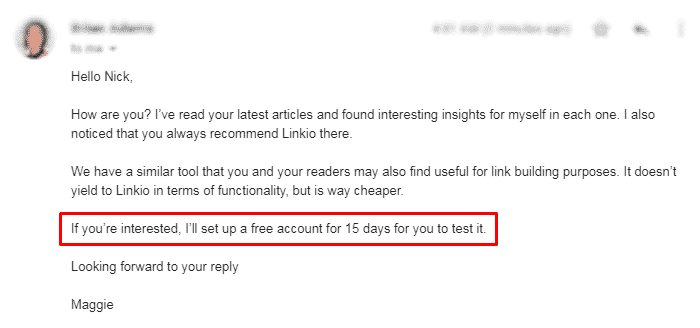
Providing two-week access to your tool for free is not enough, to say the least.
First, people can probably get it themselves by signing up for your free trial.
Second, your prospects may be too busy to use your tool straightaway. And the fact that you urge them on can cause the tension between you and them.
Solution. Share at least a few months of free access to your product.
That way, they’ll be able to check it out and hopefully get used to it after a while. When the time is up, some of them may ask you to extend their free accounts in exchange for more perks you’d like.
Note. Even if your prospects decline your backlink request, don’t discontinue their free acc. Tell them they’re still welcome to use it.
If people like your tool, they may turn into your paying customers or suggest it to their readers who may turn into your paying customers.
Higher email response rates are just the tip of an iceberg here. Your generosity will pay off in all kinds of ways.
For more inspiration, check out cold email case studies with great reply rates.
Outreach email templates to get links
Problem. To do the work at scale, you definitely need email marketing software and a good outreach email template. Before I share a few, let me clarify one thing.
The problem with templates is that many people use them as is. Yeah, they add details like their names, post titles, and links, but hardly ever rephrase the default body text.
As a result, bloggers receive almost the same templated emails and understand they’re not personal. Just look where we are now – “Delete” and “Report spam” have become the most clickable buttons in the inbox.
Solution. Do a bit of rephrasing of your outreach email template copy. The templates below are more for email structuring rather than word-for-word usage.
I hope I could guide you on how to write an outreach email pitch at every stage. None of these strategies is rocket science. All you need is some wit and a lot of practice.
Do A/B testing of different email subject lines, outreach excuses, personalization hacks, etc to figure out what works best with people in your niche.
If you want to do outreach at scale, don’t turn it into spam. Try to make the most of each email pitch you send, learning more about your outreach prospects beforehand. Yeah, you’ll need to invest some time, but it’ll help you boost response rates.
Do you have any questions about the whole process? Feel free to drop me an email, and I’ll try to help 🙂
